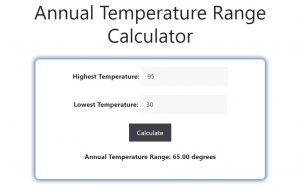About Annual Temperature Range Calculator (Formula)
The Annual Temperature Range Calculator is a valuable tool for anyone interested in understanding climate variability over the course of a year. By measuring the difference between the highest and lowest temperatures, users can assess the temperature extremes of a specific location. This data is crucial for a variety of applications, including agriculture, environmental science, and urban planning. In this article, we will discuss the formula for calculating temperature range, how to use the calculator effectively, provide an example, and answer some frequently asked questions.
Formula
The formula for calculating the temperature range is:
Temperature Range = Highest Temperature – Lowest Temperature
Where:
- Temperature Range is the difference between the highest and lowest temperatures recorded over a specified period.
How to Use
- Collect Temperature Data: Obtain the highest and lowest temperatures for the location and time period you wish to analyze.
- Substitute Values into the Formula: Input the highest and lowest temperatures into the temperature range formula.
- Perform the Calculation: Subtract the lowest temperature from the highest temperature to find the annual temperature range.
- Analyze Results: Use the calculated range to understand temperature variability and its implications for climate and environmental studies.
Example
Let’s say a location has recorded the following temperatures for the year:
- Highest Temperature: 95°F
- Lowest Temperature: 30°F
Step 1: Plug Values into the Formula
Temperature Range = 95°F – 30°F
Step 2: Calculate
Temperature Range = 65°F
In this example, the annual temperature range is 65°F, indicating significant temperature variability throughout the year.

FAQs
- What is an annual temperature range?
The annual temperature range is the difference between the highest and lowest temperatures recorded in a year for a specific location. - Why is the annual temperature range important?
It provides insights into climate variability and helps assess potential impacts on ecosystems, agriculture, and human health. - How can I find the highest and lowest temperatures?
You can use weather data from meteorological services, climate databases, or local weather stations. - Is temperature range the same as average temperature?
No, temperature range measures extremes, while average temperature is the mean of all recorded temperatures. - How does the annual temperature range vary by location?
Locations with more extreme climates, such as deserts or polar regions, typically have a larger temperature range than temperate areas. - Can the temperature range indicate climate change?
Yes, significant changes in temperature range over time can signal shifts in climate patterns due to global warming. - What factors influence temperature range?
Geographic location, elevation, proximity to water bodies, and local weather patterns can all affect the annual temperature range. - How often should I calculate the annual temperature range?
It’s beneficial to calculate it annually to track changes over time, especially in research or agricultural applications. - What is the significance of a small temperature range?
A small temperature range may indicate a more stable climate, which can be beneficial for certain crops and ecosystems. - How do urban areas affect temperature range?
Urban heat islands can lead to higher average temperatures and reduced temperature ranges compared to surrounding rural areas. - Can the temperature range affect agriculture?
Yes, a wide temperature range can impact crop selection, planting times, and yields, influencing agricultural productivity. - What role does humidity play in temperature range?
Humidity can affect perceived temperature but does not directly influence the actual temperature range calculation. - How do I record temperature data accurately?
Using calibrated thermometers and following standardized measurement protocols will help ensure accurate data collection. - Can climate models predict future temperature ranges?
Yes, climate models can project future temperature ranges based on various greenhouse gas emission scenarios. - How is temperature range related to weather extremes?
A larger temperature range may correlate with increased weather extremes, such as heatwaves or cold spells. - Does elevation impact annual temperature range?
Yes, higher elevations tend to have cooler temperatures, which can result in a different temperature range compared to lower elevations. - What are the implications of a decreasing temperature range?
A decreasing temperature range may indicate climate stabilization, which could affect local ecosystems and weather patterns. - How can this calculator be useful for environmental studies?
It helps researchers analyze temperature variability, which is essential for studying climate impacts on biodiversity and ecosystems. - Is the temperature range the same in all seasons?
No, temperature ranges can vary significantly between seasons; winter and summer may exhibit different extremes. - What is the difference between daily and annual temperature ranges?
Daily temperature range refers to the difference between the highest and lowest temperatures within a single day, while the annual range encompasses a full year’s extremes.
Conclusion
The Annual Temperature Range Calculator is a powerful tool for assessing climate variability and understanding temperature dynamics over a year. By using the simple formula to calculate the temperature range, individuals and researchers can gain valuable insights into climatic conditions, which are crucial for various fields such as agriculture, environmental science, and urban planning. Regularly analyzing temperature ranges not only helps in understanding current climate patterns but also assists in making informed decisions for the future.
